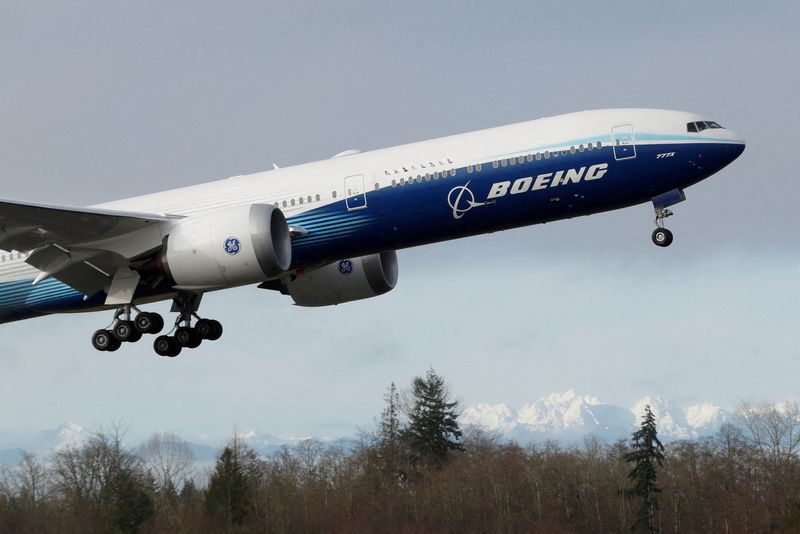By Eric M. Johnson and Tim Hepher
SEATTLE/PARIS (Reuters) - Boeing (NYSE:BA) Co's steady climb out of successive crises - among the worst in U.S. corporate history - gained momentum last week when it won the 2021 jet order race https://www.reuters.com/business/aerospace-defense/boeing-wins-annual-jet-order-race-adjusted-basis-2022-01-11 against rival Airbus SE (OTC:EADSY) on an adjusted basis with a 737 MAX sales blitz.
But closely watched orders and deliveries https://www.reuters.com/business/aerospace-defense/airbus-vs-boeing-orders-deliveries-2021-2022-01-11 have underscored the industrial and regulatory currents still facing its bigger 787 Dreamliner and 777X flagships - issues that have left Boeing fighting concurrent battles on both sides of the Atlantic.
Regulators in Europe are challenging the safety net built in to 777X flight controls and deliveries of the 787 are expected to remain frozen until around April as U.S. regulators review production flaws, senior industry and government sources said.
The pressure surrounding two of the world's largest passenger jets highlights the immediate challenge to Boeing in the aftermath of fatal MAX crashes and the pandemic, though the rest of the industry is also bracing for a regulatory crackdown.
"There is such nervousness among the regulators who make these decisions, who sign off on these things, that they are missing something," one senior air safety expert told Reuters.
"The reason for that is the aftermath of the MAX crisis https://www.reuters.com/article/uk-boeing-737max-timeline/timeline-boeings-737-max-crisis-idUKKBN27Y1RQ. What you now have is engineers looking at things differently than they ever had before," he said.
Initially designed and overseen by the same generation of engineers and U.S. regulators who oversaw the MAX, the upgrade to the large 777 has captured the attention of an increasingly assertive European Union Aviation Safety Agency (EASA).
EASA and Boeing are locked in a deeper than usual debate over engineering that will determine whether extra safeguards are needed for the jet's flight control system, the people said.
The European agency takes a back seat to the U.S. Federal Aviation Administration in certifying U.S. airplanes but its role as the other leading global regulator gives it a powerful say.
EASA has laid out an approach that could effectively force Boeing to add an extra fallback to guarantee that a single electronic failure cannot trigger simultaneous outages - a setup known as "dissimilarity." Alternatively, Boeing could try to prove that the current system is safe through thorough analysis.
A major factor in the two MAX crashes that killed 346 people was a single point of failure embedded in the flight controls.
Although the decades-old architecture at the core of the 737 is radically different from the algorithmic brains of the 777, EASA's approach reflects the intense attention given to backups.
Boeing disagrees with EASA's indirect call for additional safeguards, arguing it would amount to having two systems provided by two separate suppliers running in parallel and risk introducing new problems by adding complexity, the people said.
It is crunching data from over 1,600 hours of flight tests to build its own analysis.
Boeing and regulators declined to give detailed comment on the rare stalemate over design principles.
"As we work through the rigorous development, we continue to engage with the FAA and global regulators to ensure we meet their expectations and all applicable requirements," a Boeing spokesperson said.
EASA said it is cooperating with the FAA and noted that its job is not to dictate specific technical solutions.
"We are looking closely at the technical files with the FAA and Boeing and this work is still ongoing in an atmosphere of complete transparency and full cooperation," a spokesperson said.
The FAA said it would "not approve any aircraft unless it meets our safety and certification standards."
The financial impact of the dispute remains unclear.
A year ago, Boeing announced a $6.5 billion charge for certification delays and weaker-than-expected demand and pushed back 777X entry into service to late 2023. The design philosophy backed by EASA would delay this further, the people said.
HUMAN HAIR
In South Carolina, meanwhile, mechanics are combing through parked 787s with ultrasound devices and tools to measure gaps barely visible to the naked eye - an undertaking that makes full resumption of deliveries unlikely before April, the people said.
The gaps - left in the process for making carbon-composite structures that make the jet lighter and cheaper to fly - are the width of a human hair but violate Boeing's specifications.
Boeing says the 787's problems stem from specifications that incorporate a high safety margin and that it reported the issue itself. Still, it depends on FAA approval to restore deliveries.
Boeing delivered 14 in 2021 compared with 41 in 2020.
Now, a key question is whether the FAA will accept Boeing's assertion - backed by new analysis of composites and structural tolerances - that its initial specifications of the gaps can be tweaked without risking safety, two of the people said.
"The issues that our engineers identified and are addressing are part of our methodical approach to ensure conformance to our exacting specifications," the Boeing spokesperson said.
Boeing said in October inspections and repairs due to the structural compliance problems would be roughly $1 billion.
But factory changes and other requirements to overcome tiny structural blemishes have raised longer-term questions over Boeing's ability to build 787s at a sufficiently low cost and at the rates once planned, a person familiar with the matter said.
Boeing may be able to make up ground by wringing out inefficiencies in manufacturing. And a recent decision to focus production in one state will reduce fixed costs.
For now, scrutiny remains intense.
When it comes to small gaps in the structure surrounding the passenger and cargo doors in the aft fuselage, for example, the FAA has required painstaking manual checks of some 100 aircraft.

That is instead of allowing Boeing to test only a sample of planes.
"For decades, that was an acceptable way of saying the fleet is good," the senior safety expert said. "Having to inspect every single airplane is technically, from a safety perspective, unnecessary. But in this climate it is required."